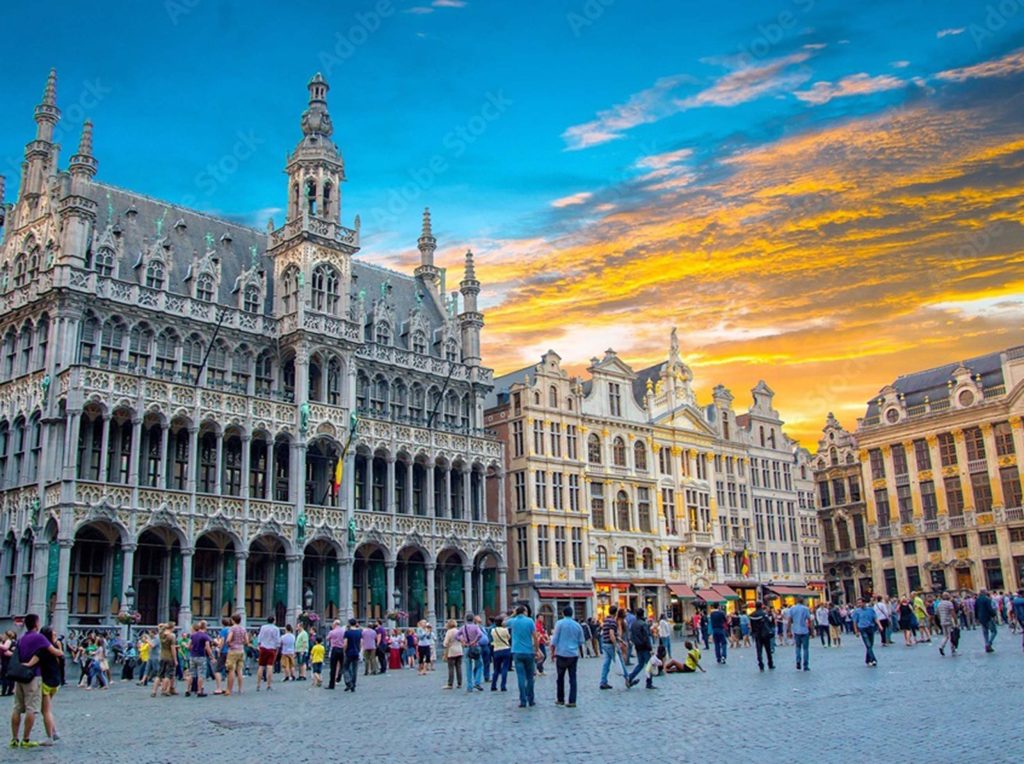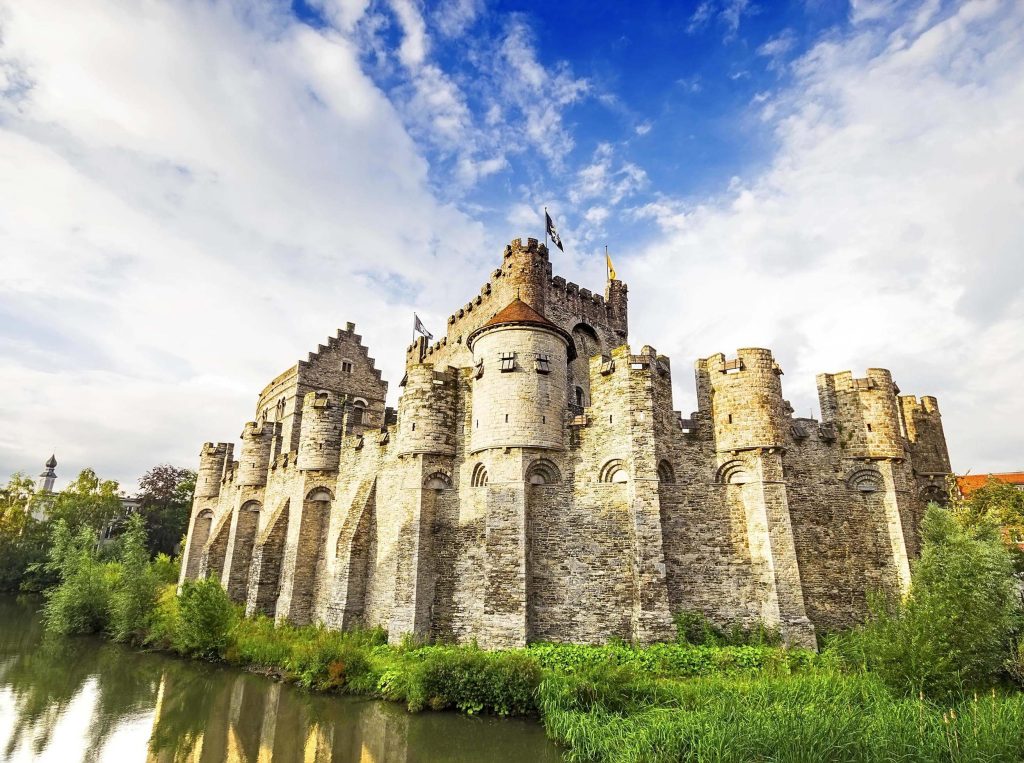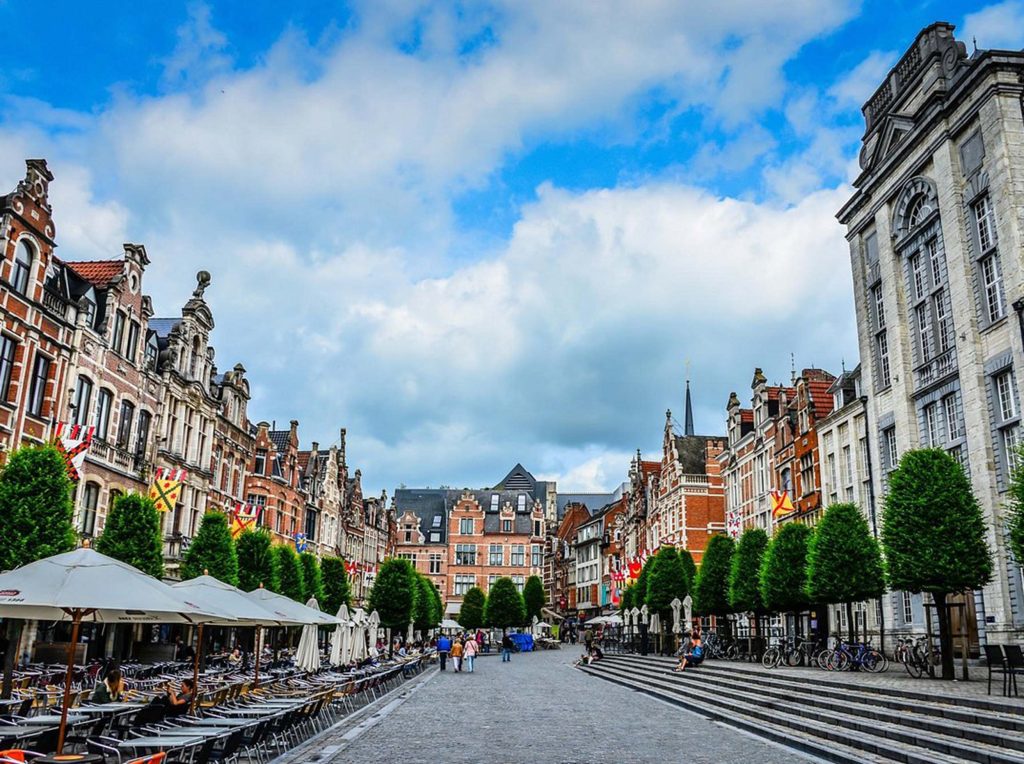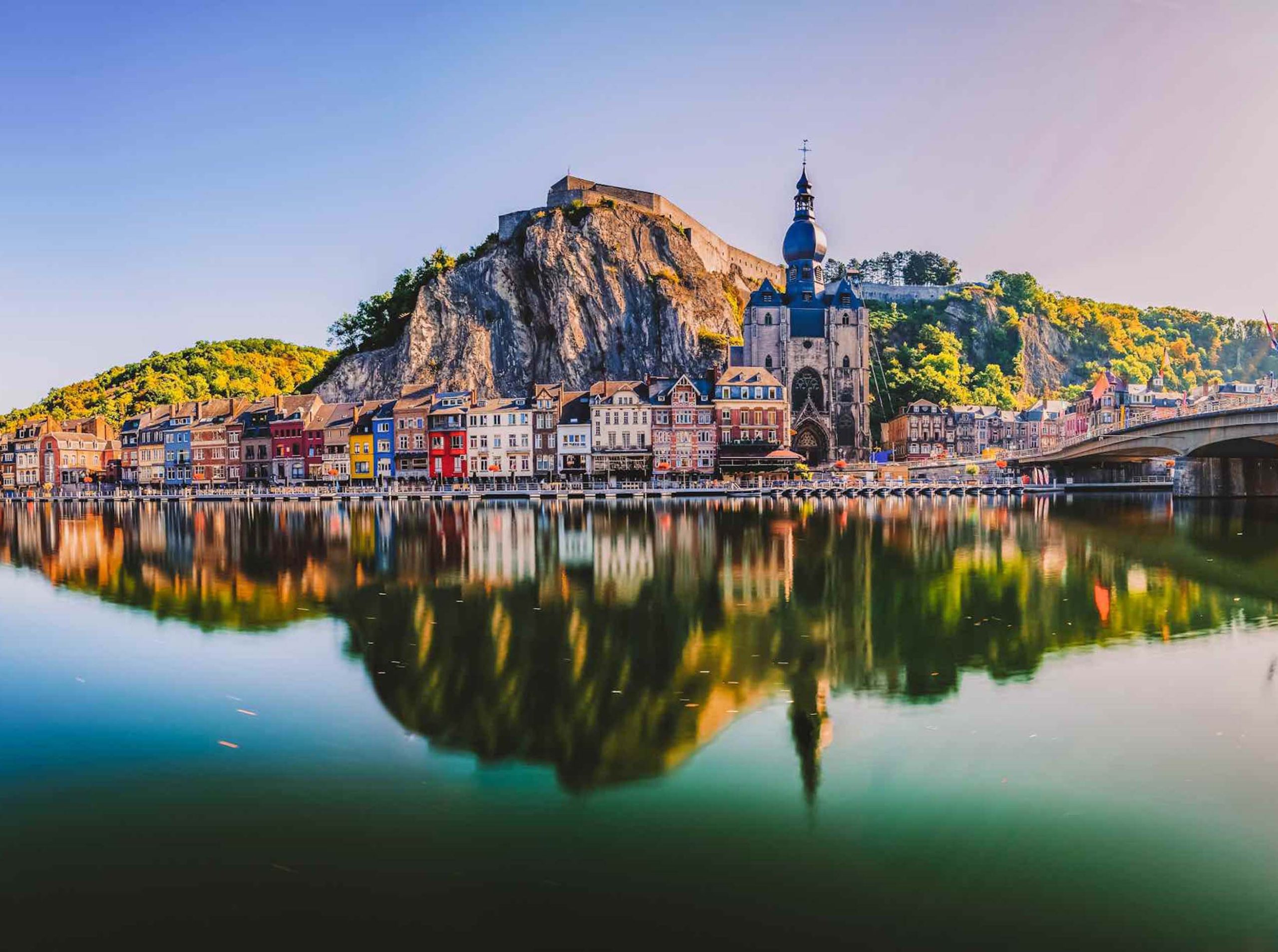Belgium, a jewel of Western Europe, offers a rich tapestry of cultural, historical, and natural attractions that make it a compelling destination for travelers. Despite its modest size, the country is brimming with picturesque cities, stunning architecture, and a culinary scene that delights food lovers from around the world.
1. Brussels – The Capital of Europe
Grand Place (Grote Markt)
The Grand Place, Brussels’ central square, is a breathtaking fusion of Gothic, Baroque, and Louis XIV architecture. Surrounded by ornate guildhalls, the Town Hall, and the King’s House, the square is the beating heart of the city. The cobblestone streets around it come alive with the annual Flower Carpet event, where the square is adorned with a vibrant tapestry of begonias. Walking through the square feels like stepping back in time, with each building telling a story of the city’s rich mercantile history. The Town Hall’s towering spire is particularly striking, serving as a focal point that can be seen from various points in the city.

Atomium
Constructed for the 1958 Brussels World Expo, the Atomium is an iconic symbol of modern architecture and ingenuity. The structure represents an iron crystal magnified 165 billion times, standing as a testament to the scientific advances of the time. Visitors can explore its futuristic spheres connected by long, narrow tubes, each offering different exhibits on science and design. The top sphere, accessible by an elevator, houses a restaurant with panoramic views of the city. The experience is both educational and visually spectacular, making it a favorite for families and science enthusiasts.
Manneken Pis
While small in stature, Manneken Pis, a bronze statue of a little boy urinating, has become a cultural icon of Brussels. The statue often reflects the city’s quirky sense of humor and is frequently dressed in costumes that range from traditional attire to outfits representing various professions or events. The nearby Jeanneke Pis, a similar statue of a little girl, and Zinneke Pis, a statue of a urinating dog, complete this trio of whimsical sculptures that showcase the city’s playful spirit.
2. Bruges – The Venice of the North
Historic City Center
Bruges, often described as a fairy-tale city, enchants visitors with its well-preserved medieval architecture and winding canals. The city center, a UNESCO World Heritage site, is a network of narrow streets lined with historic buildings and picturesque bridges. One of the best ways to experience Bruges is by taking a boat tour through the canals, offering unique perspectives of the city’s iconic landmarks such as the Church of Our Lady and the Belfry. The Markt, the city’s main square, is bustling with cafes and shops, offering a perfect spot to savor Belgian waffles or chocolate.
Belfry of Bruges (Belfort)
The Belfry of Bruges stands as a proud symbol of the city’s independence and historical significance. Climbing the 366 steps to the top is a rewarding experience, offering panoramic views of the city’s red-tiled roofs and winding canals. The climb also provides a close-up look at the impressive carillon, a set of 47 bells that have been played by hand for centuries. The sound of the bells echoing through the city adds to the magical atmosphere of Bruges, particularly during festivals and market days.
Church of Our Lady (Onze-Lieve-Vrouwekerk)
Home to Michelangelo’s “Madonna and Child,” the Church of Our Lady is a masterpiece of Gothic architecture. The church’s towering brick spire, the second tallest in the world, dominates the city skyline. Inside, visitors are treated to a wealth of art and religious artifacts, including the intricately carved tombs of Charles the Bold and his daughter, Mary of Burgundy. The church’s serene ambiance offers a quiet retreat from the bustling city, making it a must-visit for art lovers and history enthusiasts alike.
3. Ghent – A Medieval Marvel
Gravensteen Castle
The Gravensteen, or Castle of the Counts, is a formidable fortress that has stood the test of time. Built in the 12th century, the castle’s imposing stone walls and towers loom over the River Leie, evoking images of knights and medieval battles. Today, the castle is a museum that offers a fascinating look into the history of Ghent and its rulers. Visitors can explore the medieval torture devices, the grand hall, and the battlements, which provide a stunning view of the city. The castle’s well-preserved state makes it a unique historical attraction, offering a glimpse into the life and times of medieval Belgium.

St. Bavo’s Cathedral (Sint-Baafskathedraal)
This majestic Gothic cathedral is not only an architectural wonder but also a treasure trove of art and history. The highlight of the cathedral is undoubtedly the “Adoration of the Mystic Lamb,” an early Netherlandish polyptych panel painting by the brothers Hubert and Jan van Eyck. This masterpiece is one of the most significant works of the Northern Renaissance and draws art lovers from around the globe. The cathedral also houses other notable artworks and a stunning collection of stained glass windows. The crypt, with its tombs and ancient artifacts, adds to the sense of history that permeates this sacred space.
Graslei and Korenlei
These picturesque streets along the River Leie are the heart of Ghent’s historic quarter. The beautifully preserved medieval guildhalls, each with its own unique facade, tell the story of Ghent’s rich mercantile past. The area is vibrant with activity, from bustling cafes and restaurants to street performers and boat tours. Whether enjoying a meal on a terrace overlooking the water or simply strolling along the riverbanks, the Graslei and Korenlei offer a quintessential Ghent experience.
4. Antwerp – The City of Diamonds
Cathedral of Our Lady (Onze-Lieve-Vrouwekathedraal)
As one of the largest Gothic cathedrals in Northern Europe, the Cathedral of Our Lady in Antwerp is a sight to behold. Its towering spire, standing at 123 meters, is a landmark visible from across the city. Inside, the cathedral houses a remarkable collection of artworks, including four masterpieces by the Baroque painter Peter Paul Rubens. The grandeur of the interior, with its high vaulted ceilings and ornate altars, reflects the city’s historical wealth and artistic heritage. The cathedral’s treasures make it a highlight of any visit to Antwerp.
MAS (Museum aan de Stroom)
The MAS, or Museum aan de Stroom, is a striking modern addition to Antwerp’s cultural landscape. Its bold architecture, combining red sandstone and glass, stands out along the River Scheldt. The museum’s exhibitions cover a wide range of topics, including the city’s maritime history, global trade, and contemporary art. The panoramic view from the rooftop terrace offers a breathtaking vista of the city and the river, making it a popular spot for photographers and tourists. The MAS also hosts various temporary exhibitions and cultural events, making it a dynamic hub of activity.
Diamond District
Antwerp’s Diamond District is synonymous with luxury and craftsmanship. Known as the world’s diamond capital, the district is home to a multitude of diamond dealers, cutters, and polishers. Visitors can explore the many jewelry shops that showcase exquisite diamond pieces, ranging from classic designs to contemporary styles. The district also features the DIVA Museum, which offers an immersive experience into the world of diamonds, jewelry, and silversmithing. The museum’s interactive exhibits and collections provide insight into the history and craftsmanship of this glittering industry.
5. Leuven – A University City
Old Market Square (Oude Markt)
Leuven’s Old Market Square, often called the “longest bar in the world,” is a lively gathering place filled with cafes, bars, and restaurants. The square comes alive, especially in the evenings and weekends, with locals and students enjoying the vibrant atmosphere. It’s an ideal spot to sample Belgian beers, with many establishments offering a wide selection of local brews. The architecture surrounding the square, with its mix of historic and modern buildings, adds to the charm of this bustling hub.

St. Peter’s Church (Sint-Pieterskerk)
St. Peter’s Church is a beautiful example of Brabantine Gothic architecture, located in the heart of Leuven. The church is renowned for its art treasures, including the “Last Supper” by Dieric Bouts, a masterpiece of early Netherlandish painting. The church’s interior is richly decorated with altarpieces, sculptures, and stained glass windows. The accompanying museum houses a collection of religious artifacts and offers insights into the church’s history and significance.
University Library and Bell Tower
The University Library and Bell Tower are iconic symbols of Leuven’s status as a leading academic center. The library, rebuilt after being destroyed in World War I, is a magnificent building that stands as a testament to the resilience of the university community. The bell tower offers a panoramic view of the city and the university’s beautiful campus. Inside the library, visitors can explore exhibitions on the university’s history and the cultural impact of its academic contributions.
6. Namur – The Capital of Wallonia
Citadel of Namur
Perched on a hill overlooking the confluence of the Meuse and Sambre rivers, the Citadel of Namur is a massive fortress that has played a pivotal role in the region’s history. The citadel’s extensive network of tunnels and fortifications provides a fascinating glimpse into military engineering and strategy. Visitors can take guided tours of the tunnels, visit the museum, and enjoy the breathtaking views from the ramparts. The citadel also
hosts cultural events and concerts, making it a vibrant part of Namur’s cultural life.
St. Aubin’s Cathedral (Cathédrale Saint-Aubain)
St. Aubin’s Cathedral, with its classic Baroque architecture, is a key religious site in Namur. The cathedral’s elegant facade and serene interior offer a peaceful retreat in the bustling city. The interior features beautiful marble altars, intricate woodwork, and a collection of religious art. The cathedral’s surrounding gardens provide a quiet place for reflection and relaxation.
Felicien Rops Museum
Dedicated to the works of the Belgian artist Felicien Rops, this museum showcases his provocative and often controversial art. Rops was known for his satirical and sometimes erotic illustrations, which challenged the norms of his time. The museum’s collection includes drawings, prints, and paintings that explore themes of fantasy, social critique, and human nature. The museum provides an in-depth look at the life and work of this unique artist and offers visitors a chance to engage with his thought-provoking pieces.
Belgium is a country that seamlessly blends the old with the new, offering a rich cultural experience that caters to a wide range of interests. From the bustling cosmopolitan vibe of Brussels to the quaint, medieval charm of Bruges and the artistic heritage of Antwerp, there is something for everyone in this diverse nation. Whether you’re exploring historic castles, savoring world-renowned cuisine, or simply enjoying the scenic beauty of its landscapes, Belgium is a destination that promises unforgettable memories.
